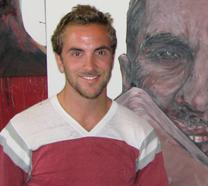Sitting in his tiny studio inside the Dominion Building, Andrew Salgado is bright-eyed and effervescent, his dog Zoe at his feet, the kind of guy you would want to introduce to your parents.
“That’s you?” I ask. He nods, smiling.
The portrait, which is plastered around town on street posts and club cards, is a stark contrast to the 25-year-old sitting across from me. In it, he is wiping blood away from his sweat-smeared face like a boxer between rounds. It’s erotic in a pugilistic way. Then he tells me what inspired it.
Salgado was with his boyfriend and a female friend when someone called him a faggot. “I’ve been called that before but something in me said, ‘You just don’t call me this’ and it was a matter of do I turn around and walk away or do I stick up for myself? And I stuck up for myself and I lost my teeth because of it. And then I was arrested because of it.”
The portrait is based on the photos his boyfriend took after the incident. No charges were ever pressed against Salgado, his boyfriend or the eight guys that attacked them.
“Everybody is so smart afterwards saying, ‘You should have done this or you should have done that’ and you say, ‘You know what? The bottom line is there’s no excuse for it.’ I can’t say it won’t happen again because there are people out there who just don’t like people for whatever reason.”
Salgado credits moving to Vancouver from Regina for helping him come to terms with his sexuality and becoming more confident as a person and an artist. Growing up in the Prairies he shied away from his sexuality for fear of upsetting his parents. Looking back on his gay adolescence he says he was using his parents as an excuse to hide his own doubts and fears.
Last month’s exhibit at the Interurban Gallery showcased Salgado’s work, from acrylics to his bolder oil canvases. He describes his work with acrylics as being rigid, studied and regimented whereas the oils are explosive and raw.
“I was done before I knew it,” he says of the self-portrait. “I don’t want to say art is my therapy, but it is a way of dealing with things.”
Salgado describes his solo show as a grassroots movement, something that would not have happened without the efforts of his friends. Most of them are featured in his art, based on photos Salgado has digitally enhanced.
Not only do his friends encourage and support him, they are walking the canvasses through the crowded Downtown Eastside by hand as we speak.
Cameron Scott, his friend from university, is impressed with Salgado’s ability to capture the essence of a person. He points to the bloodiest in the series of three paintings on violence. The subject is their friend after he had been mugged and hit in the face with a bottle.
“He’s always this happy smiley-face kind of guy, so you’ve got his happy smiling face with a big bulbous eye and a bandage on it.”
Salgado’s boyfriend explains that the big bulbous eye and Salgado’s self-portrait are bookends, that the three paintings form an arc. I ask if he could ever separate himself from the self-portrait, if it offered some sort of closure. Although they did grow individually and as a couple as a result of the attack, “that feeling of seeing Salgado with his teeth out and blood gushing and us both being arrested and hauled away and separated from each other and not allowed to be together at that moment when all we wanted was to console each other — it was horrific,” he replies.
John Lowen, with whom Salgado did his BFA, feels the move from acrylics to oils speaks to Salgado’s confidence as a painter. “The acrylics are more graphic in nature,” he says. “Closer to illustration. Whereas oil becomes a one-on-one relationship; your paintbrush explains the subject.”
After the exhibit, Salgado plans to do his Masters at Chelsea College of Art and Design. He feels that, even with the bashing, he’s been pretty fortunate.
I ask him what kind of impact he thinks the proposed Conservative budget cuts to the arts will have on queer culture.
“Artists are marginalized to a certain extent,” he says. “Queers are marginalized to a certain extent. Queer artist is just compounding it.
“It’s hard enough to get grants in this day and age. To keep slashing and cutting, it just means there’s going to be less and less people willing to take a chance and say, ‘I’m talented maybe I should pursue that and maybe I shouldn’t do my ‘safe’ degree, because that’s what I really want to do.'”

 Why you can trust Xtra
Why you can trust Xtra


